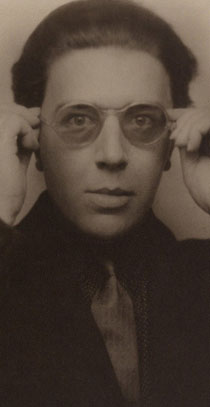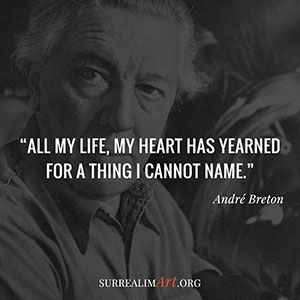André Breton, le Father of Surrealism

Writer, poet and essayist, André Breton (1896-1966) is especially known as the theorist of the surrealism.
In the early 1920s, the artist, follower of Tristan Tzara and of the other Dadaists, broke completely with the movement, disillusioned from the Dada ideas. It is on this occasion the first Surrealist Manifesto appears, which will subjugate an entire generation of literary and visual artists.
André Breton was born on February 19th, 1896, in the suburbs of Paris, in a bourgeois family. His parents imposed a hard Catholic education on him, after which he decided to pursue medical studies. It is at the end of his adolescence, in 1914, that Breton really takes the literature path: the symbolist Jean Royère, head of the literary journal La Phalange, notices the poems of young Breton, 18 years old, and puts him in touch with Paul Valery.
André Breton in times of war
During the war, Breton is assigned to various hospitals. In Nantes, he meets, in 1916, author Jacques Vaché, who immediately becomes his intellectual love at first sight. Later, Breton is transferred to Saint-Dizier, where he is an intern in the neurology center: facing the madness of the patients he meets, and obsessed with the Freudian psychoanalysis, Breton discovered what’s found in the madness is a creative force. After the war, Breton combines the important encounters: he befriended Guillaume Apollinaire and Louis Aragon, with whom he shares viewpoints on art. Breton and Aragon are among others obsessed with The Songs of Maldoror of Lautréamont, work of fiction that will be later perceived as one of the great predecessors of surrealism. In 1919, brought down by the death of Jacques Vaché, Breton is hit, as everyone in Europe at the time, by the Dada wave: he falls for Tristan Tzara and the rest of the circle of Zurich, seeing in their approach the spirit of revolt needed in the world in these hard post-war times. In the desire to support the Dada in Paris, "the three musketeers", Breton, Aragon and Philippe Soupault (poet) founded the journal Littérature, in which the great names of the literature of the time will take parts, such as Paul Eluard and Pierre Reverdy. In this journal the texts using the surrealist techniques already appear, such as the famous Magnetic Fields (1920), where Breton is already experimenting with automatic writing.
The meeting of Breton and Tzara is somewhat ambiguous: the author says of his idol that he is a "not so charismatic" being, but says that it was the effect he hoped to feel when meeting him. Francis Picabia - Dada painter and writer at the time who will follow Breton in the surrealism - Breton and Tzara organize de Dada demonstrations in Paris ... which end, most commonly, in chaotic confusion. Breton loses hope in the Dada movement. In 1920, when Picabia asks him to sign the preface of Jésus-Christ Rastaquouère, Breton refuses.
It was in 1924 that Breton and those who follow him separate officially from the Dada movement by founding the surrealism, through a series of manifestos. In the first of these proclamations, Breton describes surrealism as "pure psychic automatism by which one proposes to express, either verbally or in writing or otherwise, the actual functioning of the thought." The die is cast for Breton and Fernando Arrabal, Georges Bataille, Antonin Artaud, Paul Eluard, and all the others who will decide to follow the father of surrealism in his adventure.
Breton lives ambiguous love relationships, from which he takes inspiration for Nadja, one of his masterpieces: So, the first two volumes of the novel talk about Leona Delcourt, one of his mistresses, and the third, about Suzanne Muzard, mistress, then the wife of Emmanuel Delcourt, French journalist of the time. Simone Breton, Kahn being her maiden name, is the wife of André Breton from 1921 to 1929; they get divorced when André Breton falls madly in love with Suzanne Muzard. Simone Kahn, who until then was an important actress of the surreal scene, breaks, at the time of the break-up, every link with the members of this movement.
André Breton returns from the United States
After the Second World War, back from many years in exile in America, Breton attempts to revive the surrealist flame, without success: His relationship with Aragon fell out before the war, because of political and aesthetic differences; His relationship with Eluard also fell out, for similar reasons. During his exile, he has the opportunity to meet Léon Trotsky. Together, they compose the manifesto for an independent revolutionary art. Back in France, he has to fight against his old friend, Tzara, who presents himself as the Surrealism leader, as well as against an author who is gaining more and more influence, Jean-Paul Sartre, who, his entire career, will endeavor to demolish surrealism.
Passionate about the theory, Breton will have never stopped writing essays and books about literature, art and vocation of art. André Breton died on September 27th, 1966, from respiratory failure. He was buried in Paris, at the cemetery of Batignolles. If he didn’t succeed in the last decades of his life, to give the necessary breath back to his creation, André Breton will have inspired at least one, or even two generations of artists, internationally, whose art joins or results from this giant cultural ideology that was the surrealism.
 Arts3 Network
Websites Edition
Other articles
Origin of surrealist painting
Surrealist writing techniques
Salvador Dali
Arts3 Network
Websites Edition
Other articles
Origin of surrealist painting
Surrealist writing techniques
Salvador Dali

“All my life, my heart has yearned for a thing I cannot name.”
See more quote by André Breton
- History of Surrealism André Breton Branches of Surrealism Timeline Surrealist cinema The Automatistes Group Surrealism Manifesto Origin of surrealist painting Surrealist writing techniques
- Surrealist Artists Francis Picabia Jean Arp Joan Miro Man Ray Max Ernst
- René Magritte Biography Magritte & Lothar Wolleh
- Salvador Dali Biography Artworks Eccentric character Dali & Man Ray Dali & Picasso L'Âge d'or The Persistence of Memory The Hallucinogenic Toreador Movies Salvador Dali Museum


